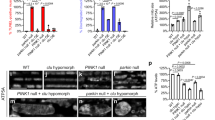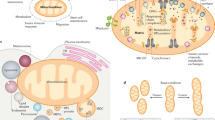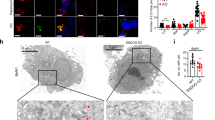Abstract
During electron transport, the mitochondrion generates ATP and reactive oxygen species (ROS), a group of partially reduced and highly reactive metabolites of oxygen1. In this in vivo genetic analysis in Drosophila melanogaster, we establish that disruption of complex I of the mitochondrial electron transport chain specifically retards the cell cycle during the G1-S transition. The mechanism involves a specific signaling cascade initiated by ROS and transduced by ASK-1, JNK, FOXO and the Drosophila p27 homolog, Dacapo. On the basis of our data combined with previous analyses of the system2, we conclude that mitochondrial dysfunction activates at least two retrograde signals to specifically enforce a G1-S cell cycle checkpoint. One such signal involves an increase in AMP production and downregulation of cyclin E protein; another independent pathway involves increased ROS and upregulation of Dacapo. Thus, our results indicate that the mitochondrion can use AMP and ROS at sublethal concentrations as independent signaling molecules to modulate cell cycle progression.
This is a preview of subscription content, access via your institution
Access options
Subscribe to this journal
Receive 12 print issues and online access
$209.00 per year
only $17.42 per issue
Buy this article
- Purchase on Springer Link
- Instant access to full article PDF
Prices may be subject to local taxes which are calculated during checkout




Similar content being viewed by others
References
Finkel, T. & Holbrook, N.J. Oxidants, oxidative stress and the biology of ageing. Nature 408, 239–247 (2000).
Mandal, S., Guptan, P., Owusu-Ansah, E. & Banerjee, U. Mitochondrial regulation of cell cycle progression during development as revealed by the tenured mutation in Drosophila. Dev. Cell 9, 843–854 (2005).
Koussevitzky, S. et al. Signals from chloroplasts converge to regulate nuclear gene expression. Science 316, 715–719 (2007).
Butow, R.A. & Avadhani, N.G. Mitochondrial signaling: the retrograde response. Mol. Cell 14, 1–15 (2004).
Grivennikova, V.G. & Vinogradov, A.D. Generation of superoxide by the mitochondrial Complex I. Biochim. Biophys. Acta 1757, 553–561 (2006).
Edgar, B.A. & Lehner, C.F. Developmental control of cell cycle regulators: a fly's perspective. Science 274, 1646–1652 (1996).
Baker, N.E. Cell proliferation, survival, and death in the Drosophila eye. Semin. Cell Dev. Biol. 12, 499–507 (2001).
Wolff, T. & Ready, D.F. The beginning of pattern formation in the Drosophila compound eye: the morphogenetic furrow and the second mitotic wave. Development 113, 841–850 (1991).
Kuzin, B., Roberts, I., Peunova, N. & Enikolopov, G. Nitric oxide regulates cell proliferation during Drosophila development. Cell 87, 639–649 (1996).
Karim, F.D. & Rubin, G.M. Ectopic expression of activated Ras1 induces hyperplastic growth and increased cell death in Drosophila imaginal tissues. Development 125, 1–9 (1998).
Wingrove, J.A. & O'Farrell, P.H. Nitric oxide contributes to behavioral, cellular, and developmental responses to low oxygen in Drosophila. Cell 98, 105–114 (1999).
Tapon, N. et al. salvador promotes both cell cycle exit and apoptosis in Drosophila and is mutated in human cancer cell lines. Cell 110, 467–478 (2002).
Baonza, A. & Freeman, M. Control of cell proliferation in the Drosophila eye by Notch signaling. Dev. Cell 8, 529–539 (2005).
Thompson, B.J. & Cohen, S.M. The Hippo pathway regulates the bantam microRNA to control cell proliferation and apoptosis in Drosophila. Cell 126, 767–774 (2006).
Newsome, T.P., Asling, B. & Dickson, B.J. Analysis of Drosophila photoreceptor axon guidance in eye-specific mosaics. Development 127, 851–860 (2000).
Robinson, K.M. et al. Selective fluorescent imaging of superoxide in vivo using ethidium-based probes. Proc. Natl. Acad. Sci. USA 103, 15038–15043 (2006).
Martin-Blanco, E. et al. puckered encodes a phosphatase that mediates a feedback loop regulating JNK activity during dorsal closure in Drosophila. Genes Dev. 12, 557–570 (1998).
Gotoh, Y. & Cooper, J.A. Reactive oxygen species- and dimerization-induced activation of apoptosis signal-regulating kinase 1 in tumor necrosis factor-alpha signal transduction. J. Biol. Chem. 273, 17477–17482 (1998).
Wang, M.C., Bohmann, D. & Jasper, H. JNK extends life span and limits growth by antagonizing cellular and organism-wide responses to insulin signaling. Cell 121, 115–125 (2005).
Essers, M.A. et al. FOXO transcription factor activation by oxidative stress mediated by the small GTPase Ral and JNK. EMBO J. 23, 4802–4812 (2004).
Xu, W., Liu, L., Charles, I.G. & Moncada, S. Nitric oxide induces coupling of mitochondrial signalling with the endoplasmic reticulum stress response. Nat. Cell Biol. 6, 1129–1134 (2004).
Kim, H.P., Ryter, S.W. & Choi, A.M. CO as a cellular signaling molecule. Annu. Rev. Pharmacol. Toxicol. 46, 411–449 (2006).
Kops, G.J. et al. Forkhead transcription factor FOXO3a protects quiescent cells from oxidative stress. Nature 419, 316–321 (2002).
Tran, H. et al. DNA repair pathway stimulated by the forkhead transcription factor FOXO3a through the Gadd45 protein. Science 296, 530–534 (2002).
Giorgio, M. et al. Electron transfer between cytochrome c and p66Shc generates reactive oxygen species that trigger mitochondrial apoptosis. Cell 122, 221–233 (2005).
Jasper, H. et al. A genomic switch at the transition from cell proliferation to terminal differentiation in the Drosophila eye. Dev. Cell 3, 511–521 (2002).
de Nooij, J.C. & Hariharan, I.K. Uncoupling cell fate determination from patterned cell division in the Drosophila eye. Science 270, 983–985 (1995).
Edward Owusu-Ansah, E., Yavari, A. & Banerjee, U. In vivo detection of reactive oxygen species. Nat. Protoc. doi:10.1038/nprot.2008.23 (published online 3 February 2008).
Acknowledgements
We thank A. Courey for his help with cell-line experiments and members of the Banerjee laboratory for comments on the manuscript. We deeply appreciate S. Ghosh's assistance with cell counting. We are indebted to Y.N. Jan (University of California San Francisco), T. Kojima (University of Tokyo), T. Orr-Weaver (Massachusetts Institute of Technology), H. Richardson (Peter MacCallum Cancer Institute Australia), W. Du (University of Chicago), I. Hariharan (University of Califonia Berkeley), R. Holmgren (Northwestern University), B. Edgar (Fred Hutchinson Cancer Research Center), B. Hay (Caltech) and the Iowa Hybridoma Center for antibodies and to B. Dickson (Research Institute of Molecular Pathology, Vienna), C. Lehner (University of Zurich), E. Hafen (Swiss Federal Institute of Technology, Zurich), F. Missirlis (University of London), M. Miura (University of Tokyo), A. Martinez-Arias (University of Cambridge) and the Bloomington Stock Center for fly stocks. We thank J. Chen, G. Call and members of the University of California Los Angeles undergraduate consortium for initial identification of the Pdsw mutant. We acknowledge the Jonsson Comprehensive Cancer Center FACS analysis core for their help in flow cytometry. This study was supported by US National Institutes of Health grant R01-EY00852 to U.B.
Author information
Authors and Affiliations
Corresponding author
Supplementary information
Supplementary Text and Figures
Supplementary Figures 1 and 2, Supplementary Table 1, Supplementary Methods (PDF 3095 kb)
Rights and permissions
About this article
Cite this article
Owusu-Ansah, E., Yavari, A., Mandal, S. et al. Distinct mitochondrial retrograde signals control the G1-S cell cycle checkpoint. Nat Genet 40, 356–361 (2008). https://doi.org/10.1038/ng.2007.50
Received:
Accepted:
Published:
Issue Date:
DOI: https://doi.org/10.1038/ng.2007.50
This article is cited by
-
Small-molecule agonist AdipoRon alleviates diabetic retinopathy through the AdipoR1/AMPK/EGR4 pathway
Journal of Translational Medicine (2024)
-
orsai, the Drosophila homolog of human ETFRF1, links lipid catabolism to growth control
BMC Biology (2022)
-
Low dose rate γ-irradiation protects fruit fly chromosomes from double strand breaks and telomere fusions by reducing the esi-RNA biogenesis factor Loquacious
Communications Biology (2022)
-
Skp2 dictates cell cycle-dependent metabolic oscillation between glycolysis and TCA cycle
Cell Research (2021)
-
Role of mitochondrial dynamics and mitophagy of vascular smooth muscle cell proliferation and migration in progression of atherosclerosis
Archives of Pharmacal Research (2021)



